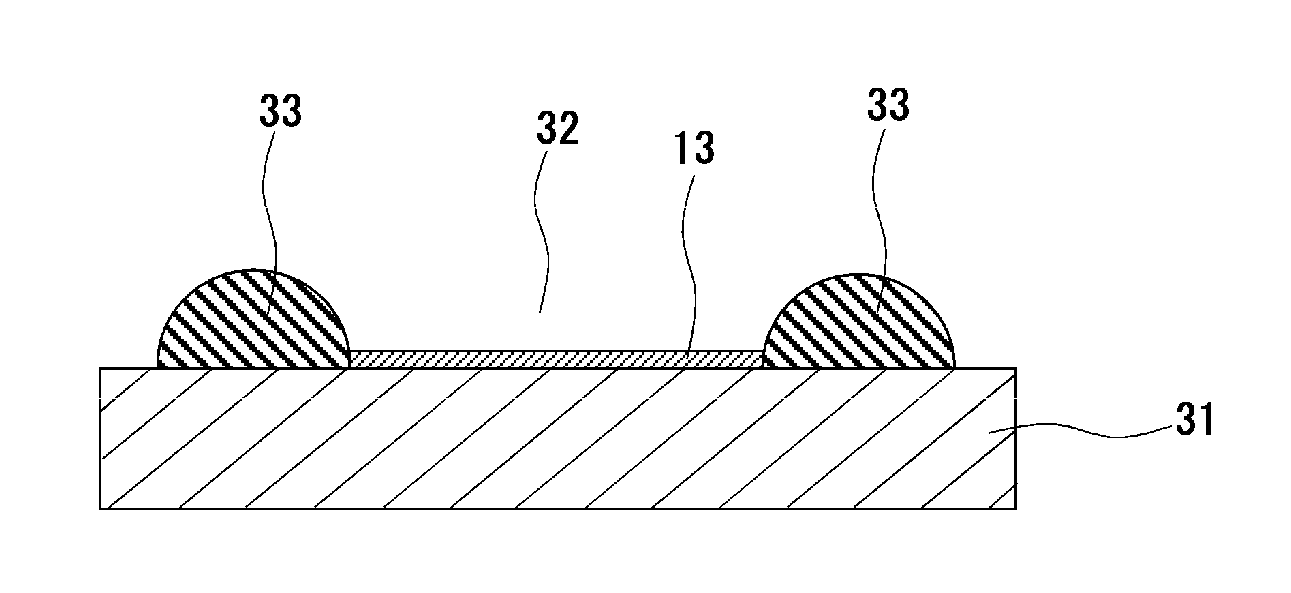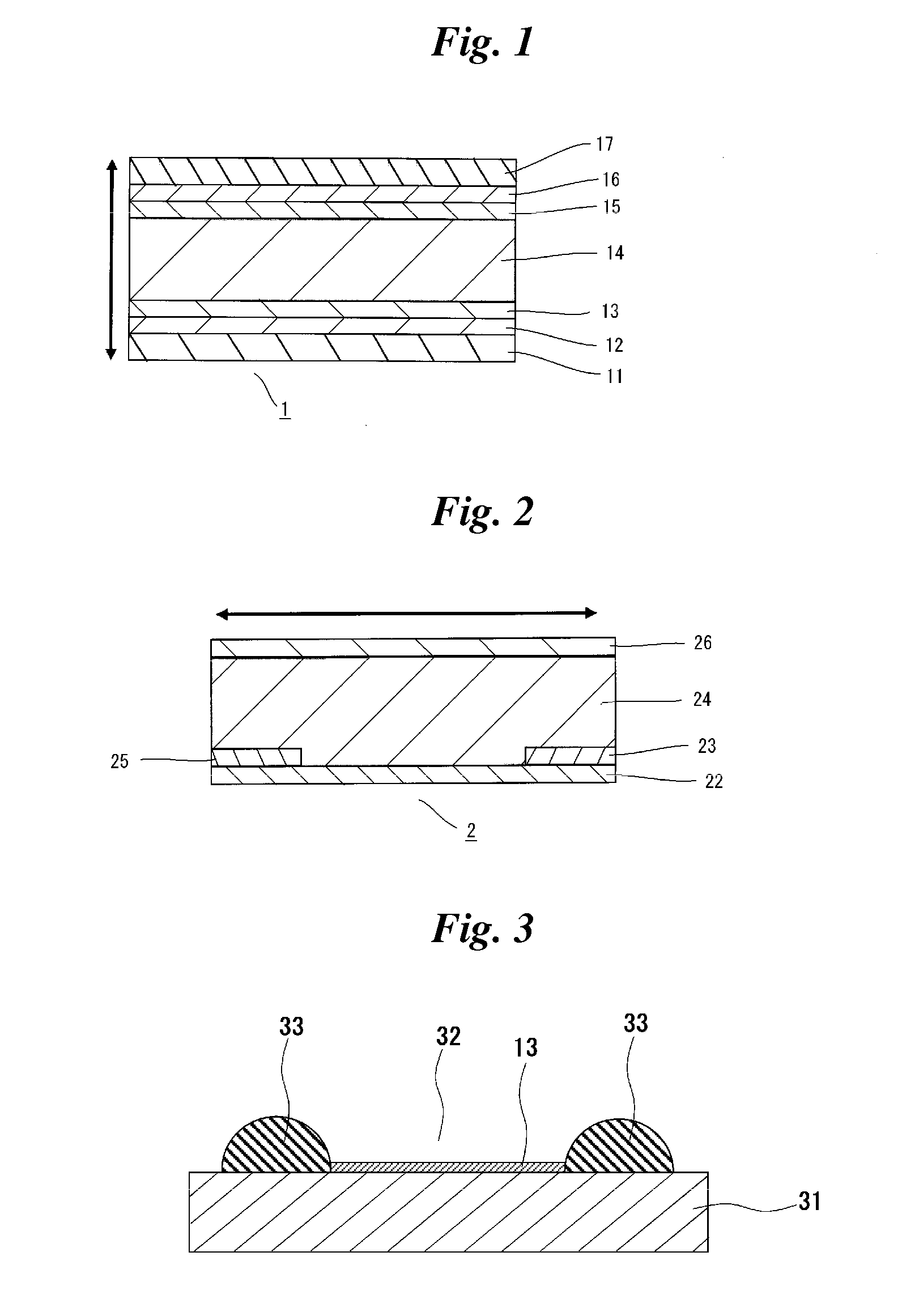Method of producing thermoelectric conversion element and method of preparation dispersion for thermoelectric conversion layer
a technology of thermoelectric conversion layer and thermoelectric conversion element, which is applied in the manufacture/treatment of basic electric elements, semiconductor devices, and thermoelectric devices. it can solve the problems of poor dispersion in the dispersion medium, achieve excellent electrical conductivity and thermoelectric conversion performance, and improve the dispersion of nano conductive materials
- Summary
- Abstract
- Description
- Claims
- Application Information
AI Technical Summary
Benefits of technology
Problems solved by technology
Method used
Image
Examples
example 3
1. Preparation of Dispersion for Thermoelectric Conversion Layer 301 and Thermoelectric Conversion Layer 301, and Production of Thermoelectric Conversion Element 301
[0513]A dispersion for a thermoelectric conversion layer 301 and a thermoelectric conversion layer 301 were prepared and a thermoelectric conversion element 301 was produced in the same manner as in Sample No. 101, except that 100 mg of 1-butyl-3-methylimidazolium hexafluorophosphate was used as a dispersant instead of poly(3-octylthiophene-2,5-yl).
[0514]The dispersibility of the dispersion for a thermoelectric conversion layer 301 prepared in this way was evaluated in the same manner as in Example 1.
[0515]Further, the film-forming property, the intensity ratio [Id / Ig], the electrical conductivity, and the thermoelectric performance of thermoelectric conversion layer 301, and the thermopower of thermoelectric conversion element 301 were evaluated in the same manner as in Example 1 or by the following method.
[0516]The PF ...
example 4
1. Preparation of Dispersions for Thermoelectric Conversion Layer 401 to 406
[0520]Dispersions for a thermoelectric conversion layer 401 to 406 were prepared in the same manner as in the dispersion for a thermoelectric conversion layer 101, except that the mass ratio of poly(3-octylthiophene-2,5-yl) and a single-walled carbon nanotube “ASP-100F” (product name, produced by Hanwha Chemical Co., Ltd.) was changed to the mass ratio as shown in Table 5 in the preparation of the dispersion for a thermoelectric conversion layer 101.
2. Preparation of Thermoelectric Conversion Layers 401 to 406, and Production of Thermoelectric Conversion Elements 401 to 406
[0521]A thermoelectric conversion layers 401 to 406 were prepared and a thermoelectric conversion element 401 to 406 were produced in the same manner as in the preparation of the thermoelectric conversion layer 101 and the production of the thermoelectric conversion element 101, using each of the dispersions for a thermoelectric conversion...
example 5
1. Preparation of Dispersion for Thermoelectric Conversion Layer 501
[0527]90 mg of poly(3-octylthiophene-2,5-yl), 20 mg of polystyrene (represented as “PPS” in Table 6, polymerization degree of 2000, manufactured by Wako Pure Chemical Industries, Ltd.) as the non-conjugated polymer, and 20 mL of o-dichlorobenzene were added and then completely dissolved by using an ultrasonic cleaner “US-2” (product name, manufactured by IUCHI SEIEIDO CO., LTD., an output of 120 W, indirect radiation). Subsequently, 90 mg of a single-walled carbon nanotube “ASP-100F” (product name, produced by Hanwha Chemical Co., Ltd.) was added and then a preliminary mixture 501 was obtained by performing the preliminary mixing using a mechanical homogenizer “T10basic” (manufactured by IKA). The solid content concentration of this preliminary mixture 501 was 1.0 w / v % (the CNT content was 45% by mass).
[0528]Subsequently, this preliminary mixture 501 was subjected to the dispersion treatment by the high-speed rotat...
PUM
| Property | Measurement | Unit |
|---|---|---|
| viscosity | aaaaa | aaaaa |
| circumferential velocity | aaaaa | aaaaa |
| length | aaaaa | aaaaa |
Abstract
Description
Claims
Application Information
 Login to View More
Login to View More - R&D
- Intellectual Property
- Life Sciences
- Materials
- Tech Scout
- Unparalleled Data Quality
- Higher Quality Content
- 60% Fewer Hallucinations
Browse by: Latest US Patents, China's latest patents, Technical Efficacy Thesaurus, Application Domain, Technology Topic, Popular Technical Reports.
© 2025 PatSnap. All rights reserved.Legal|Privacy policy|Modern Slavery Act Transparency Statement|Sitemap|About US| Contact US: help@patsnap.com



